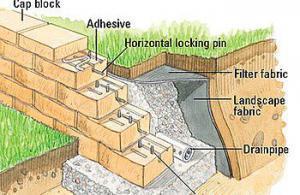Cambridge Landscapes Explain French Drains & Retaining Walls
(MENAFN – ONE Presswire)
This is a diagram of how a French drain works
A diagram of a retaining wall with a drain
A continuation of her article “Landscaping Problem Areas” – Cambridge Landscapes goes on to explain French drains and retaining walls as landscape solutions.
MORRISVILLE, PA, USA, September 16, 2020 / EINPresswire.com / – How French drains and retaining walls work
As you may have read in the Cambridge Landscaping article, “Landscaping Problem Areas,” flooding and erosion are two of the most common problems many PA homes face. Both of these can lead to major problems if ignored! Still water causes mosquito infestation, and erosion can destroy your beautiful landscaping efforts. Fortunately, there are solutions to these problems! French drains and retaining walls are a popular, good-looking, and effective remedy for damp or eroding properties. That is why in this article they explained to us how French drains and retaining walls work.
What is a french drain
French drains are drainage solutions that are used to prevent flooding or damp landscapes. It consists of a sloping trench with a perforated pipe and is usually filled with stone. This design diverts water to prevent it from building up in the problem area. Signs that you may need a drainage solution like a French drain are persistently damp or muddy areas on your lawn, or if it contains stagnant water. It can also discolor and damage your hardscaping or home. A French drain can solve these problems, but it can solve others too, including a puddled driveway, root damaged gardens, and much more!
How does a French drain work?
French drains take advantage of the fact that water always finds the easiest route to the lowest possible point. A French drain uses gravity to move the water from the problem area to a designated drainage point. Think of it like the gutters on your roof, but on the ground! The stones help attract and move the water, but can also be used to enhance landscaping.
What is a retaining wall?
Retaining walls are walls! Often used in landscaping to hold (or hold back) the soil behind. These walls can be made of a variety of materials, but are often made of stone or wood. Gravity walls depend on their own weight to hold the ground behind. Reinforced walls use layers to provide even more stable containment properties. There are other types that are used for other situations. A professional landscaper would need to look at your specific property to determine which would be better to install. One of the best things about retaining walls is that they can be very flattering, create layers in your gardens, and enhance your landscaping. They work very well on slopes or in hilly areas – a common aspect of PA life!
Design problem areas with French drains and retaining walls
If your landscape calls for it, you can have your French drain and retaining wall work together too! This can be a smart move as retaining walls alone in a lot with drainage issues can damage the structure. When you install them together, you get an elegant solution to your landscape problems.
Do you need landscaping solutions?
Finally, be sure to speak to your local landscaping company if you discover that your property has drainage or erosion issues. If you need a different solution or are ready to make your landscape dreams come true, give Cambridge Landscapes a call today! Because of their passion and expertise, your problem areas will become a nice addition to your next landscaping project! From landscaping and landscaping to water features and outdoor living, Cambridge Landscapes can make your yard a dream property.
Craig Sanford
Slicks Graphics, Inc.
+1 215-736-8000
email us here
Visit us on social media:
Facebook
Twitter
alt = “” cla>
Disclaimer: MENAFN provides the information “as is” without any guarantee. We assume no responsibility or liability for the accuracy, content, images, videos, licenses, completeness, legality, or reliability of the information contained in this article. If you have any complaints or copyright issues related to this item, please contact the above provider.


Comments are closed.